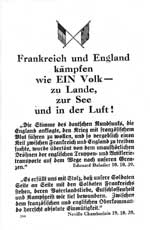 |
Department Electra House |
By now those agencies dealing with propaganda were the Ministry of Information, concerned with ‘white’ aspects and the semi secret Electra House, charged with responsibility for the propaganda inside enemy territory. Indeed, towards this aim, with Prague and Vienna targeted for the first time on the night of January 13th./14th., 1940, during the period of the ‘phoney war’ the main efforts of the Department were employed in the production of three or four varieties of leaflet, for distribution over

For the manufacture of such productions, tucked away in the trees, by the associated runway, the small green and white painted hanger of the Woburn grounds, once used to store the two aircraft – a Gipsy Moth and a Puss Moth - of the Flying Duchess, provided accommodation with an adjacent office and workshop. In fact the aircraft, wings folded, were parked one behind the other and the hanger had tall doors, hinged in sections, running within an upper and lower track. In the hangar, in September, 1939, two compositors - from the University Press at Oxford - set up a composing room to typeset the propaganda leaflets. The early versions were set by hand in old fashioned German Fraktur type and then printed by rotary letterpress at H.M. Stationery Office, in Harrow.
The German occupation of most of Western Europe, together with the entry of Italy into the war, greatly increased demands on the output of British propaganda and under the control of Harold Keeble the Woburn print unit was accordingly relocated to Marylands, near Woburn. Here, with Monotype equipment installed in a hut in the grounds, the staff of the composing room were augmented, to allow working around the clock, mostly on ‘white’ productions but also sometimes on ‘black’.

